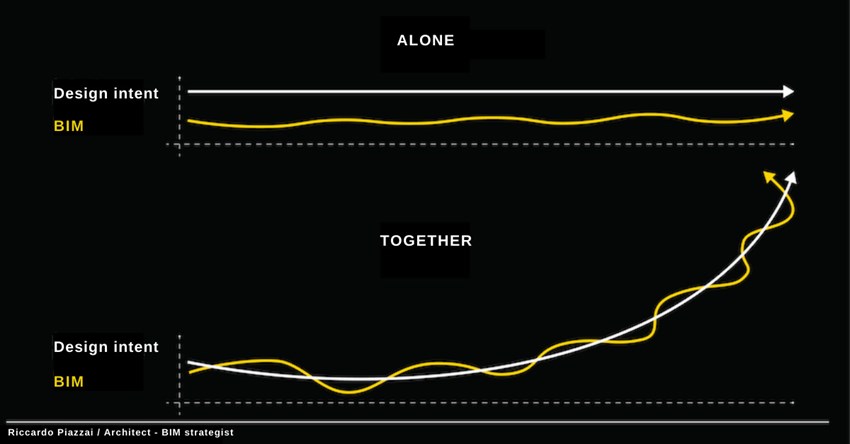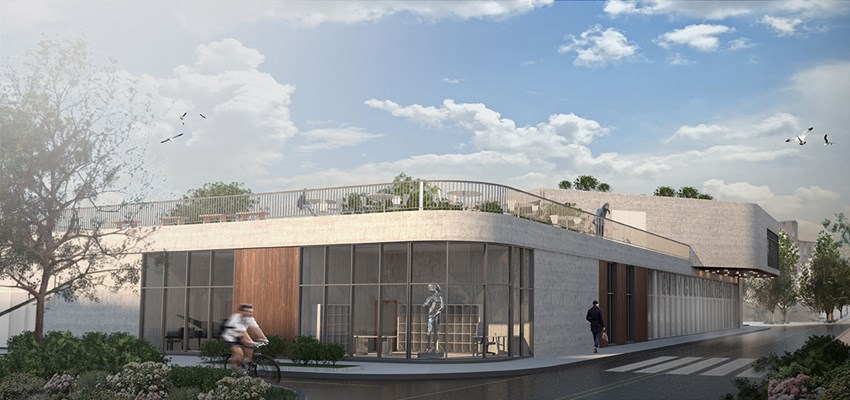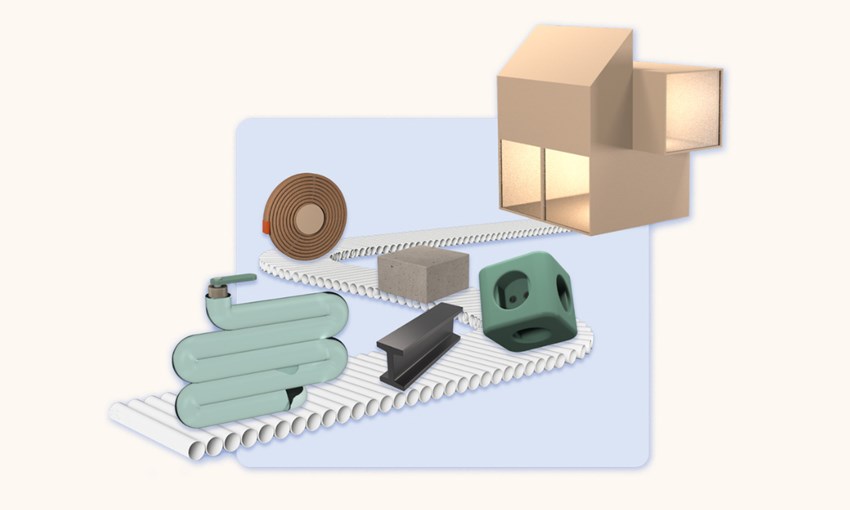
Riccardo Piazzai, Architect and BIM Project Lead at Schmidt Hammer Lassen Architects.
BIM: from concept to standard architectural practice
Riccardo Piazzai’s interest in BIM, short for building information modeling, was ignited during his University years when his friend and colleague Riccardo Pagani, founder of the well-renowned Italian consultancy firm BIMON, introduced him to the digital building process.
The two Riccardo's collaborated on the Land Transport Intermodal Hub (Centro Intermodal de Transporte Terrestre – CITT) in Mexico City – a significant project that requested the drafting of the technical offer for the tender.
The hunger to dive deeper into BIM didn’t stagnate after the last brick was laid in Mexico City. Since then, Riccardo has accelerated his BIM knowledge and skills by working with large international firms such as Perkins & Will, Mario Cucinella Architects, and his current employer: Schmidt Hammer Lassen Architects. Piazzai explains:
“I’ve taken part in large projects that used the BIM methodology in different markets such as the United States, Canada, and China, as well as different project phases and scales; from the initial stages to the executive stages.”
Although Riccardo’s projects span the world, his professional home currently resides in Schmidt Hammer Lassen Architects: one of Scandinavia’s most recognized, revered, and award-winning practices.
“Almost all the projects we take part in use the BIM methodology, which also means that consultants from other disciplines use BIM. We rarely work with companies that don’t use BIM software in-house. In those rare exceptions, we always find a way to manage the project in a BIM environment,” says Piazzai.

Want to know more about the phases of construction? Get the basics and find out where you fit in >
“The truly innovating factor lies in the creation, management and use of information.”
Piazzai explains that he carries out consultancy activities in the BIM field by promoting and sharing online know-how to build intellectual digital capital on the BIM methodology. For many professionals – Riccardo certainly included – BIM opens the doors to architectural practices and decision-making processes based on data rather than guesswork.
“The digital transformation greatly improves performances, results and processes within the construction industry. In my opinion, the truly innovating factor lies in the creation, management and use of information,” says Piazzai, and adds:
“A data-based process ensures that decisions are made solely and exclusively on the collection and processing of information. In other words: objective facts. Keeping in mind that the construction sector contributes to 37% of global CO2 emissions, it’s easy to understand digital tools' great potential in combating environmental issues.”
BIMobject: creating “considerable time savings” for Architects
BIM revolutionizes decision-making processes, how stakeholders collaborate, and how buildings are built. Architect Riccardo Piazzai says he first encountered BIMobject’s marketplace for BIM objects at the beginning of his career. But the brief acquaintance quickly turned into familiarity:
“I got to know BIMobject more closely during the 2019 BIM Concour in Paris, a contest sponsored by BIMobject and Polantis where I participated in the award ceremony for being selected among the best projects. In addition, some of the companies I worked for actively use bimobject.com.”
 Submission for the 2019 BIM Concour contest: The Socio-cultural centre in the heart of the Pyramids’ district in Évry-Courcouronnes, Paris, France.
Submission for the 2019 BIM Concour contest: The Socio-cultural centre in the heart of the Pyramids’ district in Évry-Courcouronnes, Paris, France.
The BIMobject global marketplace for BIM objects hosts 100 out of the top 100 architecture firms, more than 3 million registered users, and one file download every second. Last year, our users made us hit 100 million downloaded files. But why do professionals keep coming in – and back? Piazzai comments:
“A well-stocked BIM content catalog enables professionals to pick and compare different product options and test them in the project. This allows me to evaluate their visual and performance output, which can lead to considerable time savings.”
“Manufacturers must invest in building information modeling.”
A big part of BIM project success lies in the access and availability of BIM content. In this case, it’s up to building product manufacturers to provide the data specifiers need to specify their products in projects. But there’s a problem in the equation:
“Despite having several partners and a well-stocked library, it’s difficult to find manufacturing companies who have invested in BIM objects that we can use in our models,” says Riccardo Piazzai.
Riccardo’s comments are in unison with his industry peers in Why specifiers use BIM and 7 cases for the business value of BIM: Architects, engineers, and construction professionals want and need BIM content – but manufacturers fall short of supplying the demand.
“Manufacturers need to invest in building information modeling as soon as possible. Having a digital library of materials and components benefits professionals, developers, customers, and contractors in the decision-making process. It’s essential to optimizing the whole process,” says Piazzai, and adds:
“Investing in BIM benefits both parties: The ability to demonstrate sustainable qualities and standards brings greater reliability on manufacturers.”

BIM for social, economic, and ecological sustainability
Democracy, welfare, aesthetics, light, sustainability, and social responsibility are among Schmidt Hammer Lassen Architect’s mantras. Riccardo Piazzai’s professional aspirations align – with an emphasis on BIM and digitization as the facilitator. He elaborates:
“I’m fully convinced that innovation, technology, and digitalization are among the key factors for facilitating sustainable architecture – social, economic and ecological,” says Piazzai, and adds:
“With energy analyses, simulations, and BIM – the latter being a sustainable process in and of itself as its coordination and collaboration greatly improve the delivery of a project – it’s possible to prevent real-life issues in the digital environment, saving both time and money.”
BIM for increased energy performance
The ongoing energy crisis leaves no one untouched. Property owners, developers, governments, investors and tenants are all affected and alarmed – craving systems and structures that keep our bills and environmental impact to a minimum.
“Energy analyses are fundamental for sustainable architecture. They’re carried out at the design stage and make use of multiple systems,” says Riccardo Piazzai, and adds:
“Decisions made in the early stages of a project represent about 80% of a building’s final environmental impact and management costs. Using BIM for LEED makes it easier and faster to collate the precise data needed to create energy models for certification systems.”
LEED & BREEAM: Aim set for sustainable architecture
Riccardo Piazzai is hardly a stranger to green building certification systems. He brings up two recent projects: The Leeds General Infirmary - Hospital of the Future in Leeds, UK, and the Commonwealth Pier in Boston, USA.
“The Leeds General Infirmary - Hospital of the Future project aims for either a BREEAM or LEED certification. The building’s facade is built up as a modular system with the possibility of prefabrication; systems for heat recovery, high insulation values, low air losses, solar panels, and significant production of energy on site are part of the solutions that contribute to a sustainable hospital.”
 Rendering of the Leeds General Infirmary - Hospital of the Future project. Leeds, UK.
Rendering of the Leeds General Infirmary - Hospital of the Future project. Leeds, UK.
Governments worldwide are tightening the screw on the tenders – demanding climate declarations, green building certifications, and requiring or mandating BIM for public procurements.
“The design for the Commonwealth Pier in Boston aims for LEED Gold certification. The project incorporates advanced digital design strategies for resilience and sustainability, with the intent to preserve the unique heritage of the building while making it a modern and flexible destination," says Riccardo Piazzai.
 3D visualization of the Commonwealth Pier project in Boston, USA.
3D visualization of the Commonwealth Pier project in Boston, USA.
The future of sustainable architecture
Architect Riccardo Piazzai reflects on sustainability in symbiosis with the technological and digital development currently enveloping the world and, increasingly, the building industry. So, what does he believe the future holds in store for digitalization, sustainability, and manufacturer relations?
“I strongly believe that embracing new technologies and taking an active part in the digital transformation is not only a choice – but a responsibility. Adopting building information modeling, or other forms of digital implementation, creates countless ecological, social and economic benefits,” says Piazzai, and adds:
“It’s not just a business choice rooted in fear of being cut out of the market. Above all, it’s a responsibility we bear towards our societies in offering better services, projects, buildings, and places.”
Riccardo firmly believes that buildings are becoming – and will continue to become – increasingly energy efficient in years to come. But the process isn’t limited to energy management systems. He predicts that the focus will extend beyond:
“Buildings will become increasingly efficient in terms of energy performance. As a result, we need to focus our attention on the production, transportation, construction methods, and disposal of materials – factors that bear a large percentage of a project’s environmental impact.”
Riccardo says that most professionals are aware of the need to examine the entire lifecycle of a building. However, few have the tools to design with consciously selected materials and construction components (Psst! You can with Prodikt). But that’s one thing he believes will change in the near future:
“I’m convinced that all companies – no matter what size – will need to implement BIM and integrate it with additional strategies such as life cycle assessment (LCA).”
The world is facing many challenges where the building industry can play a part in the solution. While the statistics on the building industry’s environmental impact may seem gloomy, Riccardo Piazzai ends the interview with a bright ray of digital hope:
“I’m confident that the construction industry will continue implementing digital solutions. With the technological innovations, these tools will become available to all – enabling a sustainable revolution at a grand scale.”

Want to meet the needs of Architects & BIM Project Leads – like Riccardo Piazzai? Explore your options by setting up a quick chat with us today!











